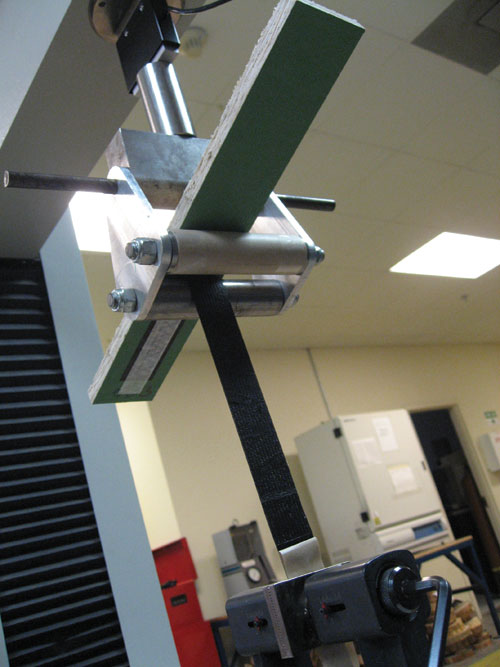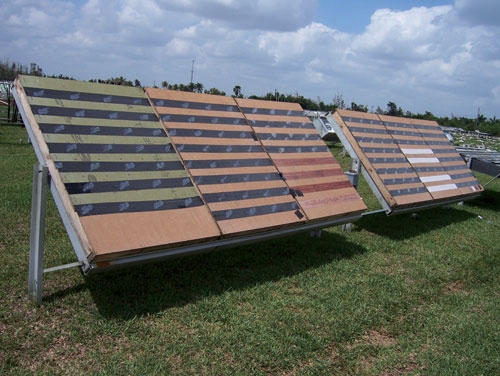Acrylic Flashing Tape Keeps It Together
Testing—Standard and“Above and Beyond”
Architects should make sure that the tape they specify is code recognized as a flexible flashing tape and performs in accordance with the latest testing criteria and is recognized in an Evaluation Service Report. If so recognized, the tape has passed requirements of AC 148 (Acceptance Criteria for Flexible Flashing Materials). Architects should ensure that the tape intended for specification has passed these standards along with AAMA 711 test criteria for flashing materials. As flashings may be exposed for extended periods during building construction, resistance to weathering damage is critical.
Rigorous Testing Methods
The more stringent tests conducted under the latest version of AC 148 include:
Tensile strength testing. After extreme UV exposure, tensile strength is tested to the point of product failure.
Adhesion testing. In order to prevent water infiltration, flashing must adhere to substrates even after exposure to water and heat. In this test, tape is adhered to various substrates and readings are taken on the force needed to peel the tape off of the substrate. In addition to control flashing tape samples, testing was completed on samples subjected to accelerated aging with UV exposure, elevated temperature exposure, and freeze-thaw cycle exposure.
Water resistance testing. After prolonged exposure to UV light and 25 cycles of soaking and drying, flashing tape samples were subjected to standing water for five hours and observed for any water leakage.
Cold temperature testing. In this test, flashing tape samples are conditioned at freezing temperatures for 24 hours and then bent to an angle of 180 degrees. Specimens are examined for signs of cracking.
Hot temperature testing. Extreme heat can damage the integrity and adhesion of many tape products. In this test, strips of flashing tape are applied to OSB in an overlapping manner to simulate the intersection of jamb and head flashings and then exposed to extreme heat (175°) for 24 hours. The flashing samples are inspected for any peeling, buckling, rippling, or edge curl.
Accelerated aging. Specimens are cut from UV exposed flashing tape samples and subjected to 25 drying and soaking cycles. These cycles consist of oven drying at 120°F for three hours followed by immersion in room-temperature water for three hours and then air-dried for 18 hours at 75°F. Specimens are then examined for leakage.
Water resistance test – ASTM E 331. This test replicates rain that a roof and wall system must withstand during the construction phase where the product is exposed. In addition to applying water spray at 32 miles per hour, a vacuum is applied to the back side of the roof/wall to try to force a failure.
Additional Level of Testing
Some manufacturers have opted to distinguish their products by further testing with extended periods of exposure to extreme heat, cold, sun, rain, and ice to assure that the tape provides the adhesion, protection, and durability that will safeguard the life of the building. The most effective products on the market will have been subjected to the following types of tests, or similar examinations. In some cases manufacturers have subjected flashing tapes to standard tests meant to evaluate other materials.
Acrylic tape in the rain. In many cases, acrylic tape performed well in tests where extreme wind and rain situations were replicated. Some of these tests include:
Wind-driven rain test – TAS 100. High-performance panel seams sealed by acrylic tape exposed to 110 mph wind-driven rain to test the water protection properties of the system indicated superiority over traditional housewrap and felt systems, which are prone to ripping and blowing off in these extreme conditions. Tests on an assembly that had been exposed to the elements for 548 days, showed that assemblies secured by acrylic tape stood up to these extremes.
Advanced water resistance test. Some manufacturers used the ASTM-331 test and increased the pressure level and required duration to determine how acrylic tapes would perform under extreme conditions. Some acrylic tapes in high-performance assemblies showed more than double the required pressure for five times the required duration.
 |
90-degree peel test. Photo courtesy of Huber Engineered Woods |
 |
Long-term outdoor exposure monitoring. Photo courtesy of Huber Engineered Woods |









